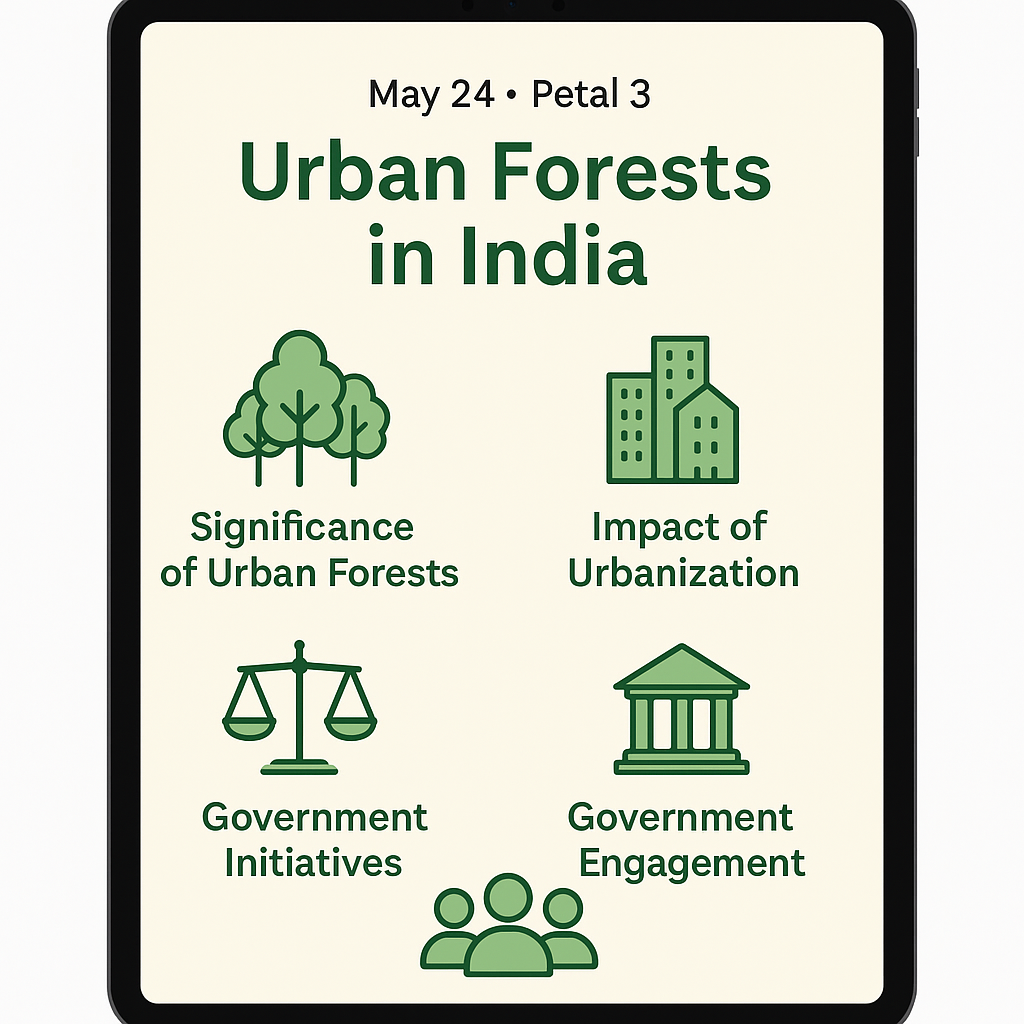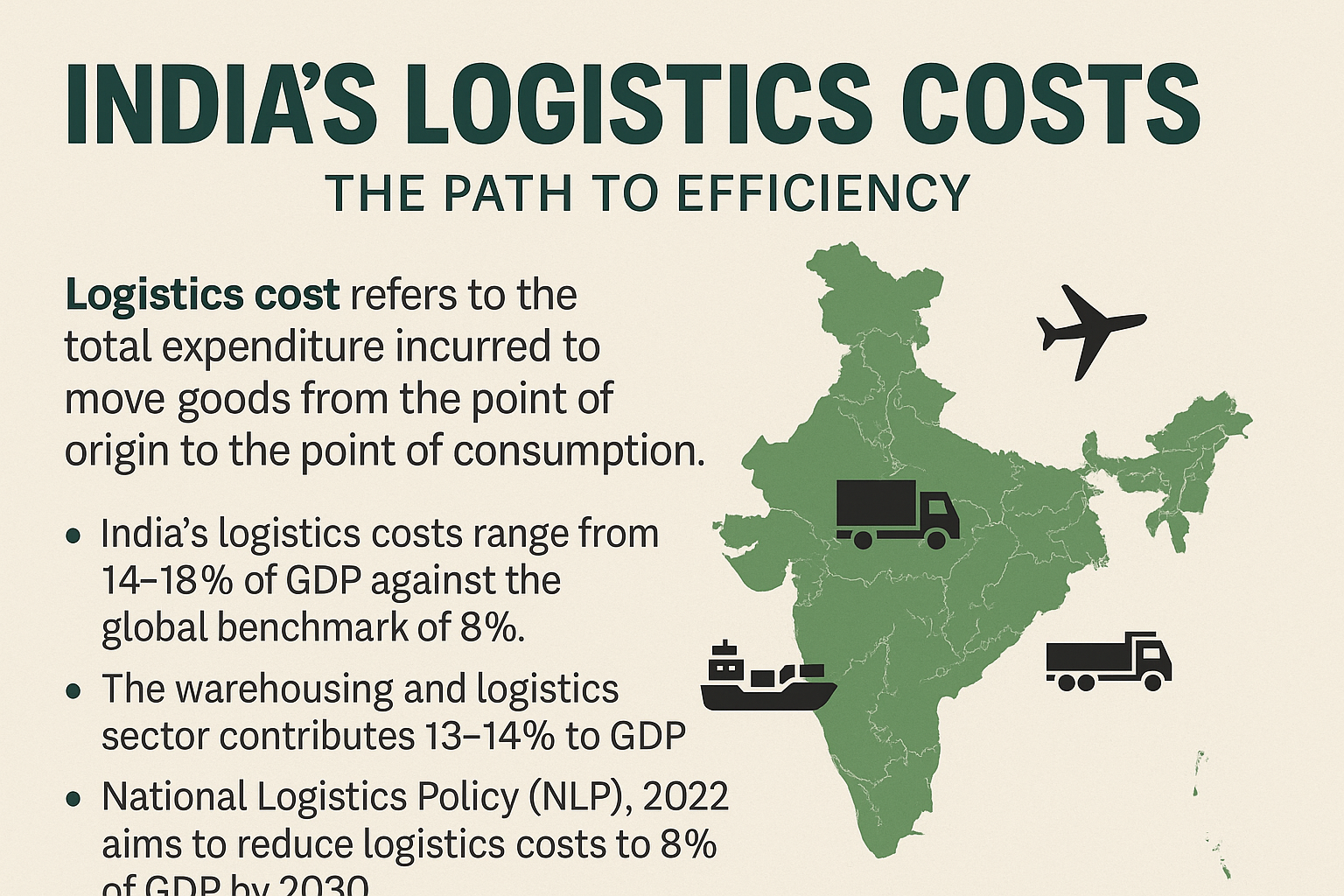
🧭May 24, 2025, Post 3: Guardians of Green: The Battle to Preserve Urban Forests in India 🌳 | High Quality Mains Essay | Prelims MCQs
Guardians of Green: The Battle to Preserve Urban Forests in India 🌳

Post 003: Date May 24, 2025
Syllabus: GS3/Environment, Urbanization, Governance
🌱 Significance of Urban Forests
Urban forests are essential for maintaining the ecological balance in rapidly urbanizing areas. They act as natural air purifiers, absorbing carbon dioxide and pollutants, which helps improve air quality 🌬️. Studies suggest that one hectare of trees can remove approximately one ton of air pollutants annually. These green spaces are crucial in mitigating climate change by acting as carbon sinks, reducing the urban heat island effect 🌳. Moreover, urban forests play a vital role in managing stormwater runoff, helping to reduce the risk of flooding 🌧️. In addition to environmental benefits, urban forests provide habitats for endangered species, enriching urban biodiversity 🦋.
🏙️ Impact of Urbanization
With the rapid expansion of cities, urban forests face growing threats. The conversion of forested lands into residential and industrial areas often leads to habitat destruction 🏗️. For instance, the Kancha Gachibowli forest in Hyderabad was nearly wiped out when the government proposed to allocate its land for industrial use. This highlights the urgent need for sustainable urban planning 🌍. Without it, the loss of green spaces could have severe long-term consequences for both the environment and urban dwellers.
⚖️ Judicial Interventions
India’s judiciary has played a pivotal role in safeguarding urban forests. Landmark cases such as the Godavarman case expanded the legal definition of forests, thereby ensuring that more areas are protected by law 📜. Judicial interventions have helped prevent illegal tree felling, emphasizing the need for legal awareness and environmental protection. The courts’ actions serve not only to preserve urban forests but also to raise public awareness about the importance of green spaces 🌿.
🏛️ Government Initiatives
The Government of India has launched several initiatives to promote urban forestry. The Nagar Van Yojana aims to establish 1,000 urban forests by 2027, helping to increase the country’s tree cover 🌳. This initiative has already resulted in the creation of numerous green spaces in urban areas. Additionally, the National Forest Policy and the Smart Cities Mission integrate environmental sustainability into urban development. These policies aim to create cities that are not just technologically advanced but also ecologically balanced 🌍.
👥 Community Engagement
Public participation plays a crucial role in the conservation of urban forests. Civil society movements have made a significant impact, as seen in the Save Aarey Forest movement in Mumbai, which received widespread support. The success of such grassroots efforts demonstrates the power of community involvement in protecting urban green spaces 🌱. Collective action can influence policy decisions and drive environmental change at the local level 🏙️.
⚖️ Environmental Legislation
India’s Constitution includes provisions that promote environmental conservation. Articles 21, 48A, and 51A(g) highlight the right to a healthy environment, empowering citizens to protect urban forests and other natural resources 🌏. These legal frameworks encourage activism and public advocacy for environmental protection, enabling citizens to challenge harmful developmental projects that threaten green spaces.
🌍 Challenges Ahead
Despite the various legal protections and government initiatives, challenges remain. Urban areas continue to expand, often at the expense of valuable green spaces 🌳. The looming threat of climate change further exacerbates the situation, making it more difficult to protect and restore urban forests. It is essential for citizens, policymakers, and environmentalists to collaborate in safeguarding these ecosystems. Sustainable urbanization will require a balanced approach, one that prioritizes the environment as much as economic development 🏙️.
🧘♂️ IAS Monk’s Whisper
“Urban forests are not just about trees; they are the lungs of our cities, breathing life into urban spaces. Protecting them is not a choice; it is a responsibility we must all share. As cities grow, let us grow with them in harmony with nature, for in every leaf lies the wisdom of our future.” 🌱
GS Paper Mapping
- GS 3: Environment, Conservation, and Urbanization
- GS 2: Governance and Public Policy (Nagar Van Yojana, Smart Cities Mission)
- GS 1: Indian Society (Role of community and judicial actions in conservation)
Challenges and Way Forward
Urban forests are crucial for the survival of cities in the face of climate change. As urbanization continues, we must think of green spaces as integral parts of city planning and not as expendable luxuries. The future of urban forests will depend on stronger judicial frameworks, public engagement, and proactive government initiatives. Together, we can create urban spaces that foster life in all its forms. 🌍🌳
High Quality Mains Essay For Practice :
Word Limit 1000-1200
Guardians of Green: The Battle to Preserve Urban Forests in India
Introduction
Urban forests, often considered the lungs of a city, are among the most valuable natural resources that urban areas can possess. They are not only critical for maintaining environmental health but also contribute significantly to the social, economic, and psychological well-being of urban populations. In a rapidly urbanizing world, the importance of urban forests cannot be overstated, especially in a densely populated country like India. As cities expand and urban sprawl encroaches on green spaces, the battle to preserve these vital ecosystems becomes increasingly urgent.
Urban forests provide essential services that mitigate the effects of climate change, improve air quality, enhance biodiversity, and offer much-needed spaces for recreation. Despite their undeniable value, urban forests in India face severe threats from rapid urbanization, industrialization, and lax enforcement of environmental laws. In light of these challenges, protecting and expanding urban forests must become a central focus of India’s urban development strategies.
The Importance of Urban Forests
Urban forests are not just aesthetically pleasing patches of greenery; they play a fundamental role in the functioning of urban ecosystems. One of the most significant benefits of urban forests is their ability to mitigate climate change. Trees and other plants absorb carbon dioxide (CO2), a major greenhouse gas responsible for global warming, thereby reducing the carbon footprint of cities. According to studies, a single hectare of mature trees can absorb roughly one ton of carbon dioxide per year.
Furthermore, urban forests help to improve air quality by filtering out harmful pollutants like sulfur dioxide, nitrogen oxides, and particulate matter. As cities grow, air pollution becomes a significant health concern, causing respiratory illnesses and other chronic diseases. Urban forests act as natural air purifiers, significantly improving public health.
Another critical service urban forests provide is stormwater management. Urban areas with large expanses of concrete and asphalt suffer from poor drainage systems, leading to flooding during heavy rains. Trees and plants absorb water, reducing runoff and decreasing the risk of floods. Additionally, green spaces help lower urban temperatures by providing shade, counteracting the heat island effect—a phenomenon where built-up areas are significantly warmer than surrounding rural areas.
Perhaps one of the most profound roles urban forests play is in biodiversity conservation. Urban forests act as sanctuaries for wildlife, providing homes for numerous species of birds, insects, and mammals that might otherwise be displaced by urban development. These forests serve as vital pockets of biodiversity within cities, helping preserve the natural heritage of an increasingly urbanized world.
The Threat of Urbanization
India is experiencing one of the fastest rates of urbanization in the world. According to estimates, by 2031, nearly 600 million people in India will live in urban areas, up from about 377 million in 2011. While urbanization brings economic growth and development, it also leads to the rapid loss of green spaces. This is particularly alarming considering that urban forests are already under threat from a variety of sources.
The expansion of infrastructure—such as roads, housing, and commercial establishments—often comes at the expense of forests and green spaces. For example, the Kancha Gachibowli forest in Hyderabad, which once provided vital green cover and habitat for numerous species, was destroyed to make way for industrial development. The encroachment on urban forests often leads to the loss of biodiversity, as many species are unable to adapt to the changes in their environment. The destruction of forests not only affects wildlife but also the human population that relies on these green spaces for health, recreation, and cultural significance.
The pollution caused by urban sprawl also takes its toll on urban forests. Excessive air and water pollution, coupled with inadequate waste management systems, can degrade the quality of soil and water in urban forests, threatening their long-term viability. The increasing demand for land, coupled with government policies that often prioritize industrial growth over environmental conservation, exacerbates the situation.
Judicial Interventions and Legal Frameworks
Given the increasing threats to urban forests, the Indian judiciary has played a pivotal role in preserving them. Landmark cases like the Godavarman case in the early 1990s expanded the legal definition of forests and reinforced the legal protections for forested areas. The case was a turning point, as it broadened the scope of forest conservation laws in India, making it difficult for developers to encroach on forested lands without rigorous environmental assessments and clearance.
Judicial intervention has not only helped preserve urban forests but has also acted as a catalyst for raising public awareness about environmental protection. The Supreme Court and various High Courts have intervened in cases where illegal tree felling or encroachment was taking place. Such actions have prompted government agencies to act more decisively and enforce environmental laws.
Government Initiatives and Policies
The Government of India has launched several initiatives to safeguard and promote urban forests. One of the most notable initiatives is the Nagar Van Yojana, which aims to create 1,000 urban forests across the country by 2027. This initiative is designed to restore the ecological balance of urban areas by increasing green cover. As part of this initiative, many cities have seen the establishment of new green spaces, which have significantly improved air quality and public health.
Another key policy that supports urban forest conservation is the National Forest Policy. This policy emphasizes the importance of environmental sustainability and encourages the integration of green spaces in urban development plans. Additionally, the Smart Cities Mission, launched by the Government of India, aims to build sustainable and eco-friendly urban centers. This mission includes provisions for increasing tree cover, promoting urban forestry, and incorporating green spaces into urban infrastructure projects.
Despite these initiatives, much work remains to be done to ensure that urban forests receive adequate protection and investment. The success of these programs depends on strong collaboration between various stakeholders, including the government, civil society, and the private sector.
Community Engagement and Public Participation
While governmental efforts are vital, the role of communities in urban forest conservation cannot be overstated. In India, grassroots movements have successfully mobilized against the destruction of urban forests. The Save Aarey Forest movement in Mumbai, which gained widespread support from the public, is a prime example of how community involvement can influence policy decisions. This movement not only protected the Aarey Forest from development but also raised awareness about the importance of urban forests in the broader context of climate change and sustainability.
Public participation can also help address the challenges of maintaining urban forests. Urban forests require regular care and protection from human activities, and communities can play a crucial role in monitoring these areas, preventing illegal felling, and participating in tree plantation drives. Additionally, environmental education and awareness campaigns can empower local communities to understand the importance of urban forests and take active steps to preserve them.
Legal Framework and Challenges Ahead
India’s Constitution recognizes the right to a healthy environment under Articles 21, 48A, and 51A(g), which collectively empower citizens to advocate for the protection of natural resources. These legal provisions form a solid foundation for the environmental activism that is necessary to protect urban forests.
Despite these frameworks, urban forests continue to face significant challenges. Rapid urbanization, industrial growth, and climate change exacerbate the pressures on these green spaces. The conversion of urban forests into built-up areas remains a major threat, as does the lack of adequate funding for forest conservation programs. Furthermore, political and economic interests often clash with environmental concerns, making it difficult to strike a balance between development and conservation.
Conclusion
Urban forests are an indispensable part of India’s ecological and social fabric. They provide essential services that enhance the quality of life in cities, from improving air quality and mitigating climate change to fostering biodiversity. However, the relentless pressure of urbanization poses significant threats to these green spaces. Judicial interventions, government initiatives, and community engagement are key to preserving and expanding urban forests in India.
To ensure that future generations can benefit from the multitude of services provided by urban forests, it is essential for citizens, policymakers, and environmentalists to work together. The need for sustainable urban planning and environmental stewardship has never been greater. Only through collective action can we ensure that our cities remain livable, green, and sustainable for years to come.
The time to act is now, for the forests that stand in our cities are the guardians of our future. 🌍🌿
Target IAS-26: Daily MCQs :
📌 Prelims Practice MCQs
Topic: Urban Forests in India 🌳
MCQ 1 – Type 1: How many of the above statements are correct?
Consider the following statements regarding Urban Forests in India:
1. Urban forests help mitigate climate change by absorbing carbon dioxide and pollutants.
2. The Nagar Van Yojana aims to establish 500 urban forests by 2027.
3. Urban forests contribute to biodiversity by providing habitats for endangered species.
4. The Kancha Gachibowli forest in Hyderabad was preserved due to judicial intervention.
How many of the above statements are correct?
A) Only one
B) Only two
C) Only three
D) All four
🌀 Didn’t get it? Click here (▸) for the Correct Answer & Explanation
✅ Correct Answer: C) Only three
🧠 🌀 Explanation:
•1) ✅ True – Urban forests are carbon sinks and reduce pollution.
•2) ❌ False – The Nagar Van Yojana aims to establish 1,000 urban forests by 2027, not 2025.
•3) ✅ True – Judicial interventions, like the Godavarman case, helped protect urban forests.
•4) ✅ True – Urban forests help manage stormwater and mitigate flooding.
MCQ 2 – Type 2: Type 2: Two-Statement Type
Consider the following two statements regarding Urban Forests in India:
1. The Nagar Van Yojana aims to establish 1,000 urban forests across India by 2027.
2. The Kancha Gachibowli forest in Hyderabad was preserved due to strong community opposition.
Which of the above statements is/are correct?
A) Only 1 is correct
B) Only 2 is correct
C) Both are correct
D) Neither is correct
🌀 Didn’t get it? Click here (▸) for the Correct Answer & Explanation
✅ Correct Answer: A) Only 1 is correct
🧠 Explanation:
•1) ✅ True – The Nagar Van Yojana aims to increase tree cover in cities.
•2) ❌ False – The Kancha Gachibowli forest was destroyed due to government allocation of land for industrial purposes.
MCQ 3 – Type 3: Code-Based Correct Statement Selection
Which of the following statements regarding Urban Forests in India are correct?
1. Urban forests contribute to biodiversity by providing habitats for endangered species.
2. The Nagar Van Yojana aims to establish 1,000 urban forests by 2027.
3. Urban forests have no role in mitigating the effects of climate change.
4. The Smart Cities Mission incorporates urban forestry as part of its development plans.
Select the correct code:
A) 1, 2, and 4 only
B) 1, 3, and 4 only
C) 2, 3, and 4 only
D) 1, 2, 3, and 4
🌀 Didn’t get it? Click here (▸) for the Correct Answer & Explanation
✅ Correct Answer: A) 1, 2, and 4 only
🧠 Explanation:
• 1) ✅ True – Urban forests provide habitats for a variety of species, contributing to the conservation of biodiversity in urban areas. They serve as sanctuaries for endangered species displaced by urbanization.
• 2) ✅ True – The Nagar Van Yojana is indeed aimed at establishing 1,000 urban forests by 2027, contributing to urban greenery and environmental sustainability.
• 3) ❌ False – Urban forests do play a significant role in mitigating the effects of climate change. They act as carbon sinks by absorbing carbon dioxide and pollutants from the atmosphere, thus helping reduce global warming and air pollution.
• 4) ✅ True – The Smart Cities Mission has incorporated environmental sustainability in its planning, including urban forestry, to create green, livable cities that contribute to environmental health.
MCQ 4 – Type 4: Direct factual question
What is the primary goal of the Nagar Van Yojana?
A) To establish 1,000 urban forests by 2027
B) To create a green belt around cities
C) To plant trees on every rooftop
D) To restore deforested areas in rural India
🌀 Didn’t get it? Click here (▸) for the Correct Answer & Explanation.
✅ Correct Answer: A) To establish 1,000 urban forests by 2027
🧠 Explanation:
•The Nagar Van Yojana aims to establish urban forests, promoting sustainable urbanization.


















